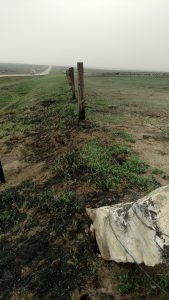controlled burn
By Walt Fick, range management specialist
 How does fire intensity impact plant response? Fire intensity varies with the amount of vegetation to burn, moisture content of the vegetation, and weather conditions at the time of burning. Last year was a good forage production year across most of Kansas, consequently there was plenty of plant material to burn in 2017.
How does fire intensity impact plant response? Fire intensity varies with the amount of vegetation to burn, moisture content of the vegetation, and weather conditions at the time of burning. Last year was a good forage production year across most of Kansas, consequently there was plenty of plant material to burn in 2017.
The National Weather Service started issuing Red Flag Warnings back in February. A Red Flag Warning indicates good conditions for extreme fire behavior. This usually means relative humidity < 25%, wind speeds > 15 mph with frequent gusts > 25 mph, warm air temperatures e.g. >75oF, and 10-hour dead fuel moisture < 9%. Prescribed burning should not be conducted during a Red Flag Warning.
Wildfires, such as the Starbuck Fire in Clark and Comanche counties in March this year occurred with these severe fire weather conditions. Wildfires under these extreme fire weather conditions are difficult to extinguish. Once the vegetation is removed sandy soils will tend to erode. Fortunately, most of the plant biomass is below ground in the form of roots and rhizomes. Plant communities dominated by rhizomatous grasses such as big bluestem, Indiangrass, and switchgrass are usually not harmed much by fire. However, yield of little bluestem, a bunchgrass, is often reduced by March wildfires. Shortgrass communities dominated by blue grama and buffalograss are also harmed by wildfire conditions in March. Plant communities in central and western Kansas may take three years to fully recover from wildfire assuming drought doesn’t occur. Further information on rangeland management following wildfire can be found at http://www.bookstore.ksre.ksu.edu/pubs/L514.pdf. Intense fires are more apt to cause damage to woody plants such as eastern redcedar and other species that may be leafed out at the time of burning.
Time of burning can have an impact on vegetation. Burning during the dormant season will result in a loss of soil moisture. That impact may be greater in central and western Kansas. Having good soil moisture at the time of burning is critical in areas where average rainfall is less. In eastern Kansas, a long-term date of burning study indicated prescribed burns in December or March resulted in a 15-16% decrease in forage production. However, in some years forage production may not be decreased as adequate rainfall is received to offset lost soil moisture. Although burning in early spring may reduce biomass, species diversity and perennial forbs will be benefited. Burning in mid- to late-April does not reduce forage production and results in increased forage quality during the first 2 months of the grazing season. Stockers gain an additional 32 lbs/animal on late-spring burned rangeland compared to unburned pasture. Warm-season grasses are generally favored by late-spring burning. Prescribed burning is important for maintaining our prairie ecosystems. A long-term lack of fire allows woody plants to completely displace our prairie grasses and forbs in 35-40 years in the Tallgrass Prairie. Burning at any time will reduce the impact from wildfires, remove thatch and litter, and improve grazing distribution. A summer burn may do more damage to certain woody species.
Fire intensity and time of burning can both have an impact on forages. Extreme fire intensity often occurs with wildfires, but can be used with prescribed burning to impact unwanted woody species. Time of burning depends on the objectives you want to accomplish. Early spring burns will benefit perennial forbs. A late-spring burn favors warm-season grasses and stocker gains. Timing of a prescribed burn is not as critical if your objective is to reduce the impact from wildfires, remove thatch and litter, and improve grazing distribution.
This is a question: What would you think of an August 1 burn of grass used for short season intensive grazing—May 1 to July 31, leaving enough fuel for the burn?
First of all, there must be litter or dead growth to carry a prescribed burn conducted around August 1. Assuming the pasture will burn and there is adequate soil moisture or rainfall, the new growth will provide high quality forage until the end of the season. Grazing animals could use this new growth, but enough leaf area needs to remain to allow production and storage of carbohydrate reserves going into the dormant season.